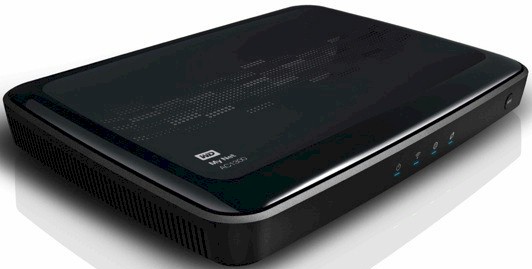
| At a glance | |
|---|---|
| Product | Western Digital My Net AC1300 HD Dual-Band Router (WDBWNJ0000NBL) [Website] |
| Summary | Broadcom-based AC1750 router with Gigabit ports and two USB 2.0 ports for file and printer sharing |
| Pros | • Dual USB ports • IPv6 support • Good balance of wired and wireless performance |
| Cons | • USB 2.0 vs. USB 3.0 ports • No transmit power adjust or wireless on/off scheduling |
Typical Price: $79 Buy From Amazon
Introduction
It has taken me waaaay too long to review WD’s draft 802.11ac router that it sent me lo, so many months ago. Unfortunately, it arrived at the point where I was switching over to the new wireless test process, which I wanted to test it with. So, my thanks to WD for being patient while I worked out the kinks in the new process.
The My Net AC1300 establishes the top of WD’s My Net "HD" router line as shown in the comparison chart from WD’s website below. We reviewed the N900 last July and the AC1300’s routing features are essentially the same.
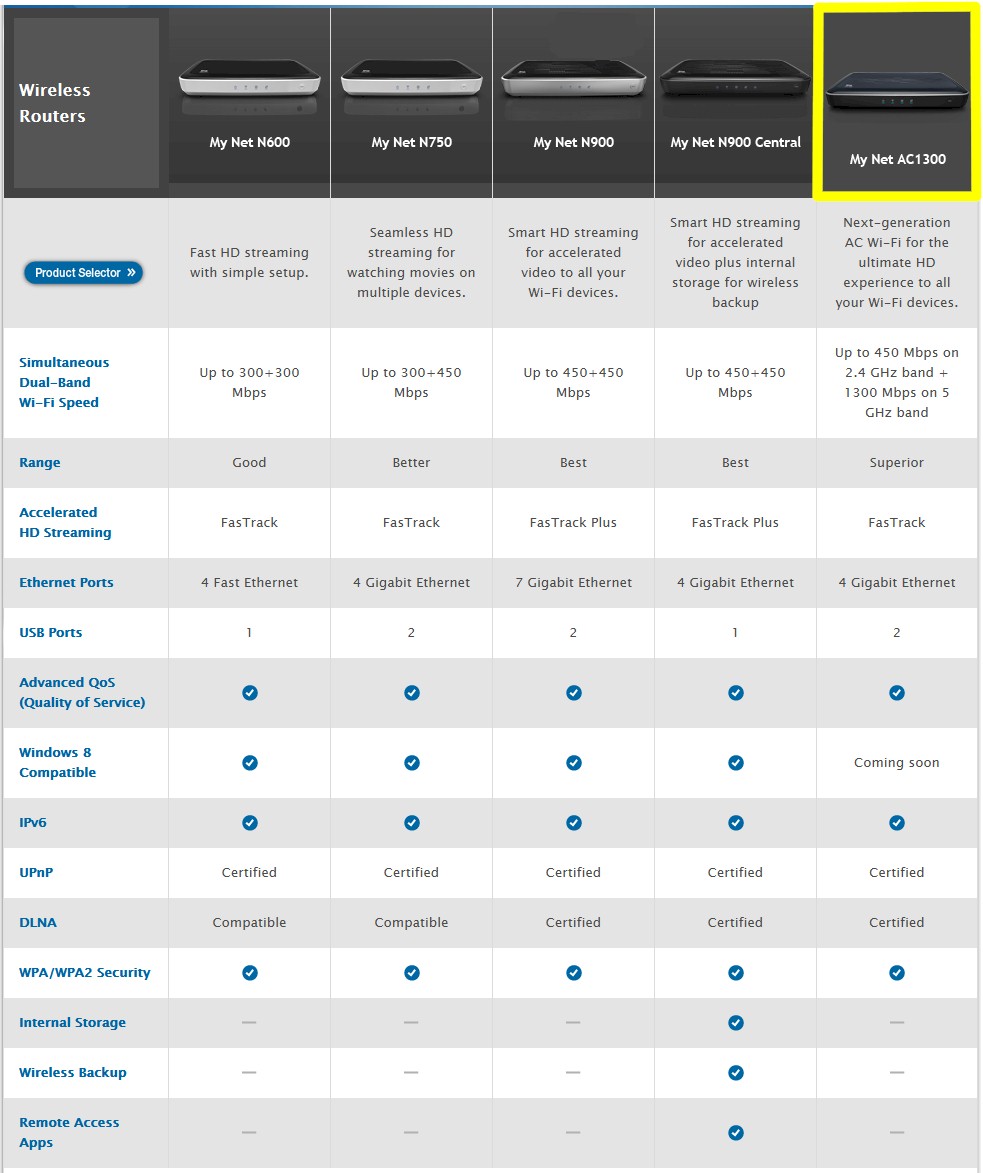
WD My Net Router family
The main difference between the two is on the wireless side with the AC1300 being a 3×3 802.11a/b/g/n/ac router vs. the N900’s 3×3 802.11a/b/g/n radios. The AC1300’s 2.4 GHz radio supports a 450 Mbps maximum link rate and its 5 GHz radio tops out at 1300 Mbps. Despite WD’s moniker, our wireless router classification system slots the AC1300 as an AC1750 class product.
Fans of the N900’s unique built-in seven port Gigabit switch will be sad to see only the usual four-port switch in the AC1300. But at least it remains Gigabit. Potential buyers may also have mixed feelings about the USB ports. The AC1300 still provides two, but they are still USB 2.0 vs. the faster USB 3.0 ports starting to appear in the new crop of draft 11ac routers based on Broadcom’s newer router SoC.
Storage sharing functions still include SMB, FTP, DLNA, iTunes and "cloud" access via WD 2go. Printer sharing also still requires installation of WD Print Share software. But now there are versions for both Windows and Mac OS.
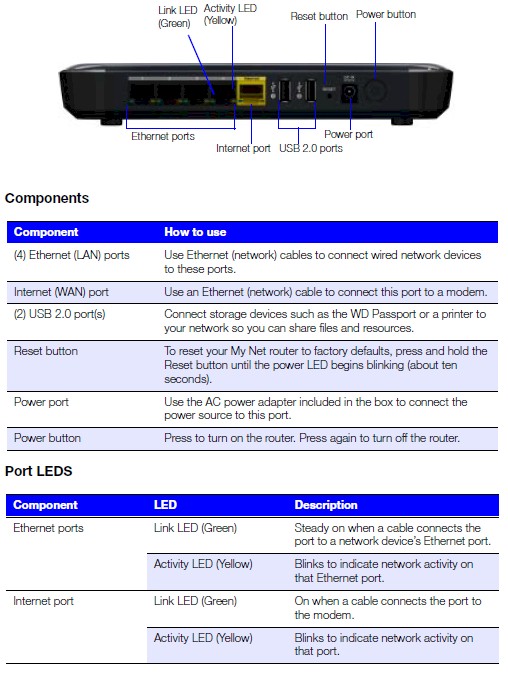
My Net AC1300 rear panel
The front panel contains a WPS button and handy status/activity LEDs.
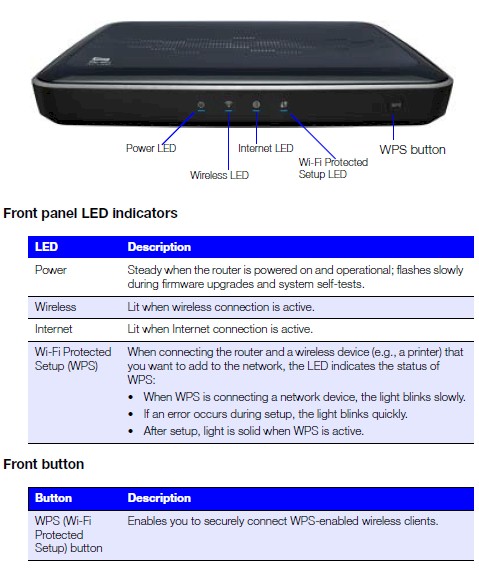
My Net AC1300 front panel
Inside
Like all other first-generation draft 802.11ac routers, the AC1300 sports essentially the same all-Broadcom design. The FCC ID says the design comes from CyberTAN Technology, a seasoned Taiwanese OEM/ODM. Since the FCC ID photos are so fuzzy, I popped the top of my review sample after testing and took off two of the RF shields to confirm the processor and switch used.
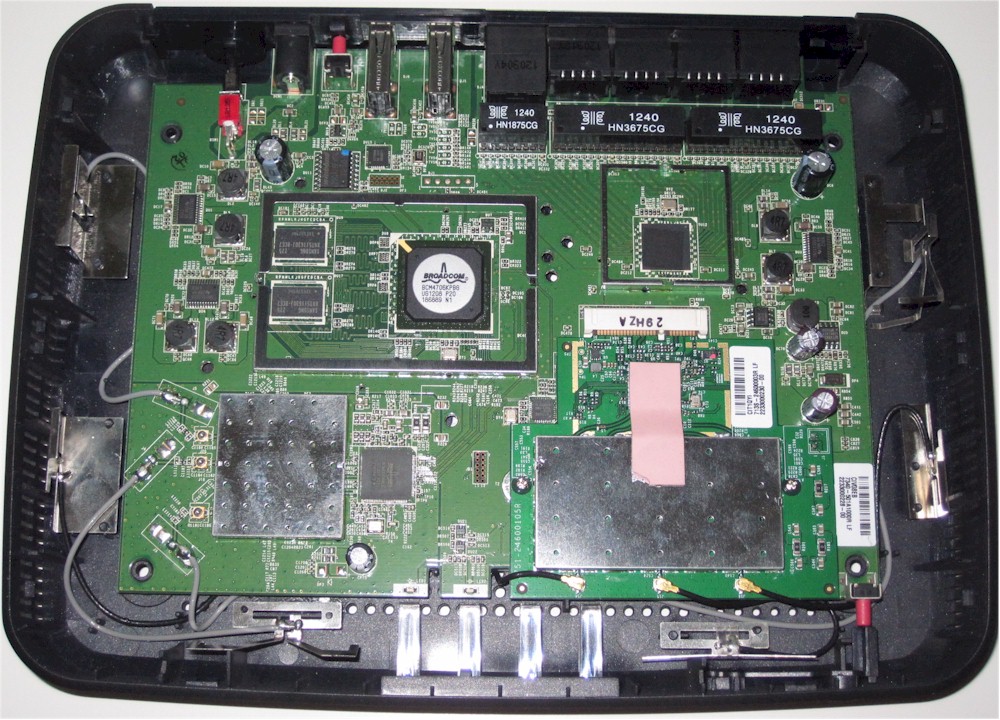
WD My Net AC1300 inside
The key components are summarized in the table below. I was surprised to see so little flash memory compared to other draft 11ac routers, which usually have 128 MB. The mini PCI-e format of the 5 GHz radio belies the AC1300’s design age. Later designs have the 5 GHz radio integrated onto the main board, as is the 2.4 GHz radio already.
| WD My Net AC1300 | |
|---|---|
| CPU | Broadcom BCM4706 |
| Switch | Broadcom BCM53125 |
| RAM | 128 MB |
| Flash | 16 MB |
| 2.4 GHz Radio | – BCM4331 – Unidentifiable 2.4 – 2.5 GHz Power Amp (x3) |
| 5 GHz radio | – Broadcom BCM4360 – Unidentifiable 5 GHz Power Amp (x3) |
Table 1: My Net AC1300 component summary
I didn’t take the top off the RF sections of the two radios. The FCC photos are clear enough to show three devices within each radio’s RF shield. I assume they are external power amplifiers, similar to those found in other first-gen Broadcom draft 11ac router designs. The photo’s aren’t clear enough to ID the specific manufacturers, however.
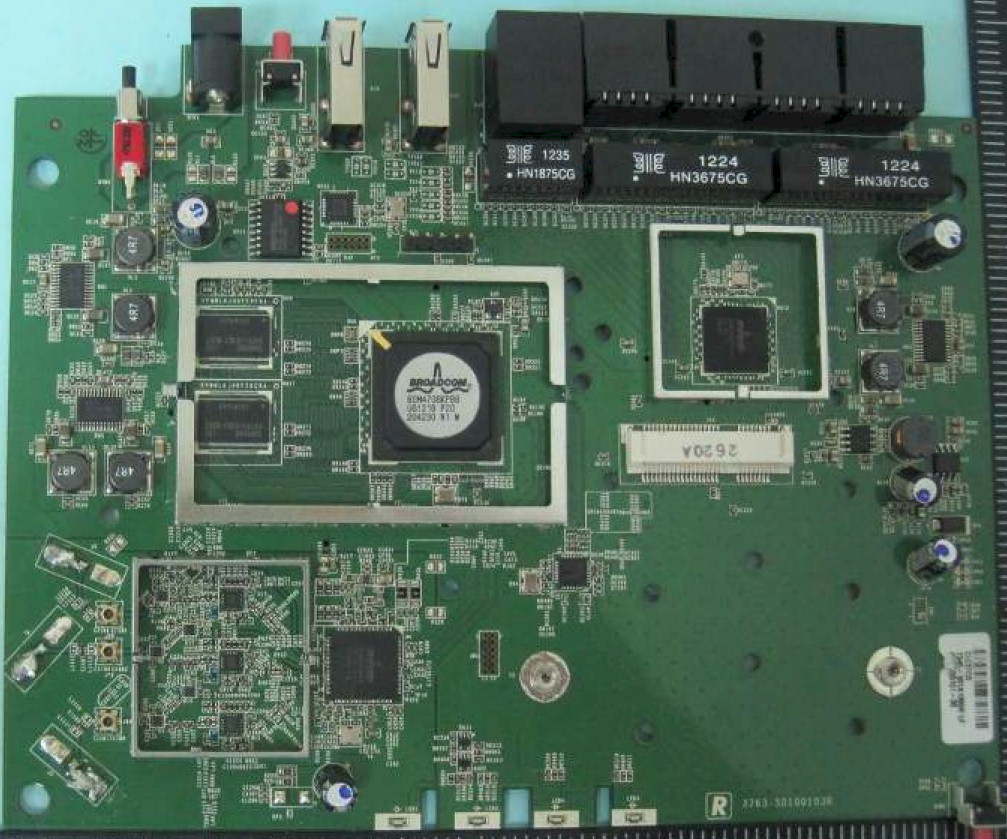
WD My Net AC1300 board detail
Features
The AC1300’s feature set is identical to the other My Net routers. So if you need more details, just mosey on over to the N900 review. I’ve include the Dashboard shot from that review below so that you get a feel for the admin GUI.
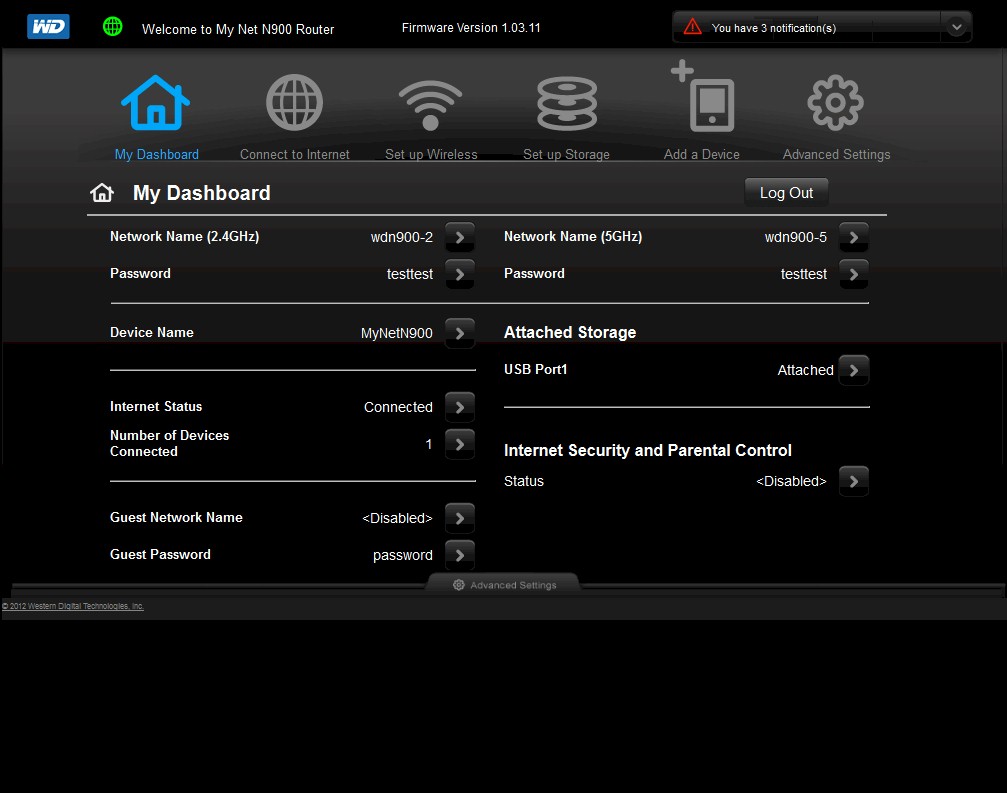
WD My Net N900 (and AC1300) My Dashboard
Table 2 summarizes the AC1300’s key wireless settings, which have a few changes from the N900’s. Both bands default to Auto Channel Width with 20/40 for 2.4 GHz and 20/40/80 for 5 GHz. ![]()
The 5 GHz radio offers one less channel (165) than the N900. The 5 GHz channel list lops off a few more low band channels (36 and 48) when you are in the default mode. Just switch to 20/40 MHz mode and you’ll see the other channels.
| Setting | 5 GHz | 2.4 GHz |
|---|---|---|
| Channel | Auto [default], 36, 40, 44, 48, 149, 153, 157, 161 | Auto [default], 1 – 11 |
| Network Mode | 802.11a only 802.11n only 802.11ac only 802.11 a+n 802.11 n+ac Mixed 802.11 a+n+ac[default] |
802.11b only 802.11g only 802.11n only Mixed 802.11 b+g Mixed 802.11 g+n Mixed 802.11 b+g+n [default] |
| Channel Width | 20/40 MHz 20/40/80 MHz (Auto) [default] |
20 MHz 20/40 MHz (Auto) [default] |
| Security | None WPA2 Personal WPA Personal WPA/WPA2 Personal WPA2 Enterprise WPA Enterprise WPA/WPA2 Enterprise WEP (legacy only) |
|
Table 2: Wireless settings summary
There is still no transmit power control, no ability to set maxiumum link rates and no wireless on/off scheduling. You do get guest network support, however, on both bands with separate security modes.
Storage Performance
I ran Windows filecopy tests using the standard NAS testbed connected to the AC1300 with our standard USB drive (Startech USB 3.0 eSATA to SATA Hard Drive Docking Station (SATDOCKU3SEF) containing a WD Velociraptor WD3000HLFS 300 GB drive) formatted in FAT32 and NTFS. The results are summarized in Table 3, along with other draft AC routers and the My Net N900.
| My Net AC1300 | My Net N900 | Linksys EA6500 | ASUS RT-AC66U |
Buffalo WZR-D1800H |
NETGEAR R6300 |
|
|---|---|---|---|---|---|---|
| FAT32 Write | 7.0 | 12.9 | 4.8 | 9.0 | 7.3 | 8.6 |
| FAT32 Read | 6.4 | 21.7 | 10.7 | 9.9 | 11.8 | 10.2 |
| NTFS Write | 8.3 | 20.8 | 7.7 | 13.5 | 8.4 | 11.3 |
| NTFS Read | 6.5 | 21.3 | 9.5 | 9.4 | 8.7 | 10.3 |
Table 3: Router filecopy performance comparison – MB/s
None of the first-generation Broadcom draft 11ac routers are particularly high performers for storage sharing, the AC1300 included. The Ubicom-powered My Net N900 beats them all handily with about twice the filecopy throughput for all benchmarks run except FAT32 write.
Routing Performance
Routing performance was measured running the latest 1.03.09 firmware, using our router test process. Table 4 summarizes and compares the AC1300 and My Net N900’s routing throughput. The N900, with its Ubicom processor seems to have more routing power, although both with handle the ISP bandwidths that most of us can get or are willing to pay for.
| Test Description | AC1300 | N900 |
|---|---|---|
| WAN – LAN | 643 | 708 |
| LAN – WAN | 778 | 728 |
| Total Simultaneous | 658 | 1106 |
| Maximum Simultaneous Connections | 43,014 | 16,384 |
| Firmware Version | 1.03.09 | 1.03.11 |
Table 4: Routing performance
The Maximum Simultaneous Connection result of 43,014 was surprising in that my test setup usually hits its limit well before that. At any rate, that number does represent the limit of my test method and not the router.
Since the N900 produced significantly different results with and without its "FasTrack QoS" kicked in, I tried it both ways on the AC1300. I didn’t find much difference between the two (I maxed out the uplink speed by entering 99999), so the results in the table above are with QoS disabled. Note that FasTrack QoS comes enabled by default.
The IxChariot throughput sumary below shows well-behaved unidirectional throughput, but a stuggle for dominance between up and downlink in the simultaneous bandwidth test.
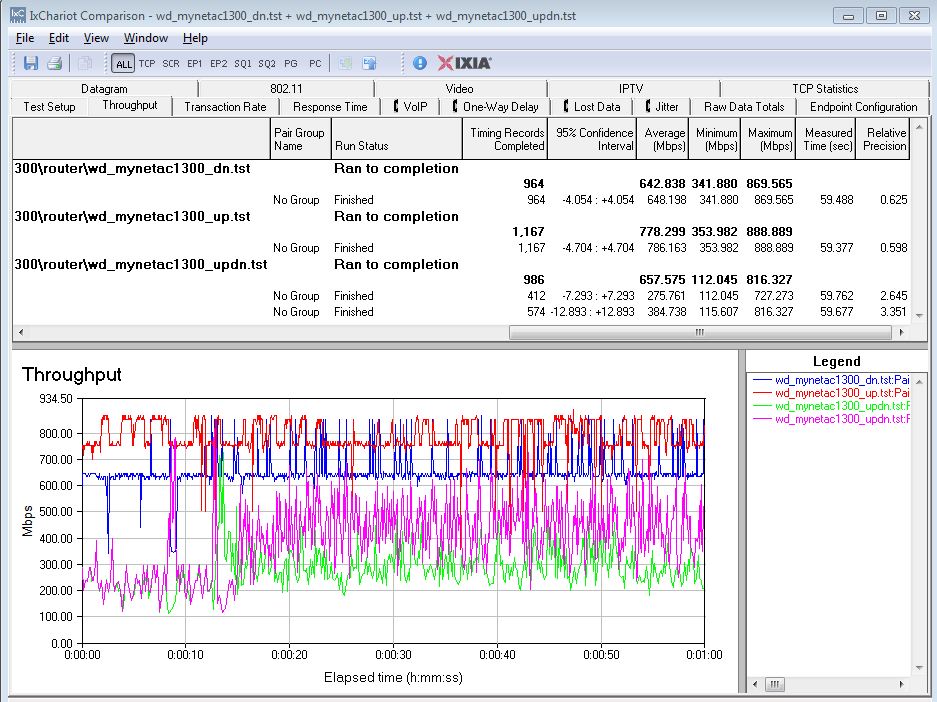
AC1300 routing throughput summary – FasTrack Plus Qos off
Wireless Performance Overview
The AC1300 is Wi-Fi Certified with the 2.4 GHz radio defaulting to Auto 20/40 MHz mode and the 5 GHz to Auto 20/40/80 mode upon power-up. The radios default to different SSIDs (MyNetAC1300 for 2.4 GHz and the same plus _5G for 5 GHz).
The router comes with WPS enabled and prompted me to enter the router PIN when I first wirelessly connected to it. After about 30 seconds, I was connected with a WPA2/AES secured network. But I could no longer see the 5 GHz SSID. After logging into the router admin, I saw that the network name that I entered during the WPS pushbutton session had been applied to both radios. So I had to reset the 5 GHz SSID to differentiate it.
I ran 40 MHz Coexistence and Fat channel intolerant tests to see if the AC1300 properly refrained from switching into 40 MHz bandwidth mode. The router was a bit too sensitive, falling back to 20 MHz link rates when I set it to Channel 7 with another router beaconing in Channel 11. Setting the AC1300 to channel 6 successfully brought back 40 MHz link rates. Setting the Fat Channel Intolerant bit caused a fallback to 20 MHz mode when I reconnected to the AC1300. But after disabling the bit and reconnecting, I found the link still at 20 MHz mode rates.
1.03.09 firmware was loaded for all testing, which was done using the new Revision 7 process. The new process uses ASUS’ PCE-AC66 AC1750 PCIe adapter to test all wireless routers and APs. The AC1300 was tested in 20 MHz mode only in the 2.4 GHz band and 80 MHz mode in the 5 GHz band.
The router was reset to factory defaults and Channel 6 was set for 2.4 GHz and Channel 153 for 5 GHz. The test client was connected using WPA2/AES encryption. The router antennas were positioned 8" from the test chamber antennas in the "0°" test position (front of router facing antennas).
The retest Benchmark Summary below shows the Consolidated benchmark process results. Remember that the summary shows the average of throughput measurements made in all test locations.
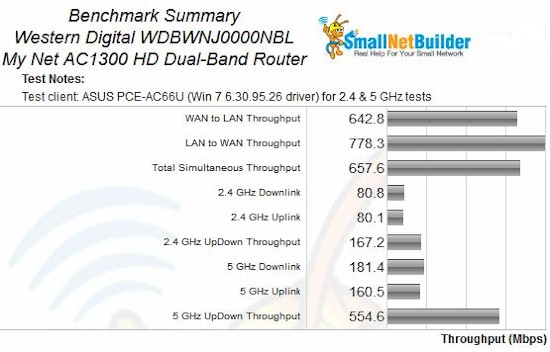
WD My Net AC1300 Benchmark Summary
Wireless Performance – 2.4 GHz
Our new test process lets us see how throughput varies over a wide range of signal levels. So we’ve added another comparison tool to our Charts toolset, the Performance vs. Attenuation Plot. To access it, just go to the Router Charts and select one of the "Profile" benchmarks you’ll now see in the Benchmark selector. You have four to choose from—up and downlink in both 2.4 and 5 GHz bands. To get you started, here’s a link to the 2.4 GHz downlink profiles.
Note that these Profile views are available only for products tested with the new Revision 7 test process. We now have three AC1750 class products tested or retested, so I included the retested ASUS RT-AC66U and Linksys EA6500 for comparison in the plots.
Here’s what the plot looks like for 2.4 GHz, downlink (router to client). The ASUS doesn’t have as many plot points because it was retested when I was using 5 dB steps. So I’ve entered only the values that correspond with 3 dB test points that I now use.
Despite the fewer plot points, you can clearly see that the ASUS maintains higher throughput than both the WD and Linksys as attenuation increases, i.e. signal level drops. The WD has a steadier throughput level out to 24 dB of attenuation, but then both products fall off at an uncannily similar rate.
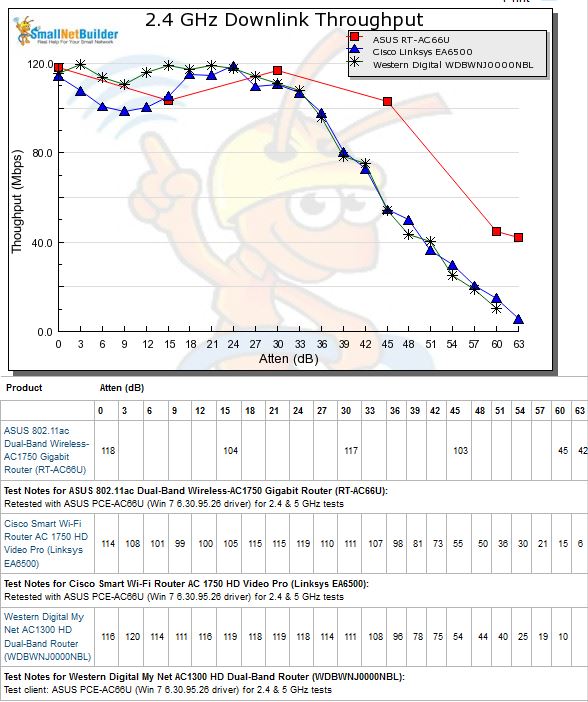
2.4 GHz Downlink Throughput vs. Attenuation comparison
All three products have about the same maximum throughput, between 114 and 118 Mbps. These throughputs are higher than we found in the recent Linksys EA6300 review, because it has only a 2×2 radio with 130 Mbps maximum link rate in the 20 MHz bandwidth mode we test with.
The 2.4 GHz uplink plot is next. Maximum values are similar to downlink and fall between 114 and 119 Mbps. The ASUS still maintains higher throughput as signal levels drop, but this time both the WD and Linksys curves are very well matched over the entire attenuation range.
Simultaneous uplink/downlink throughput in the strongest signal "Location A" (or with 0 dB attenuation) came in at 167 Mbps for the AC1300.
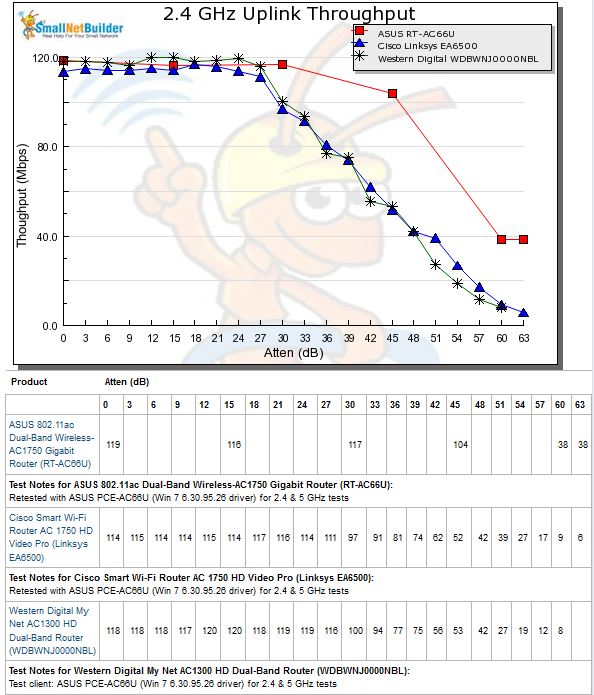
2.4 GHz Uplink Throughput vs. Attenuation comparison
Wireless Performance – 5 GHz
Best case 5 GHz downlink throughput of 352 Mbps with 0 dB attenuation ("Location A") was about 40 Mbps better than both the Linksys and ASUS delivered. Note, however, that the Linksys and WD curve once again generally track each other. Also again, the ASUS maintains its throughput edge over the tested attenuation range.
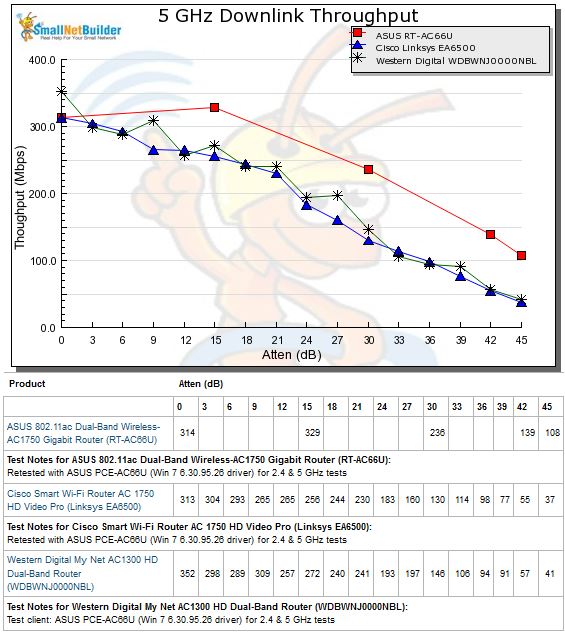
5 GHz Downlink Throughput vs. Attenuation comparison
The 5 GHz uplink plot is the only one of the four plots to show a distinct separation among the three products, with the ASUS highest, the Linksys lowest and the WD in between. Best case "Location A" / 0 dB throughput for the AC1300 came in at 290 Mbps.
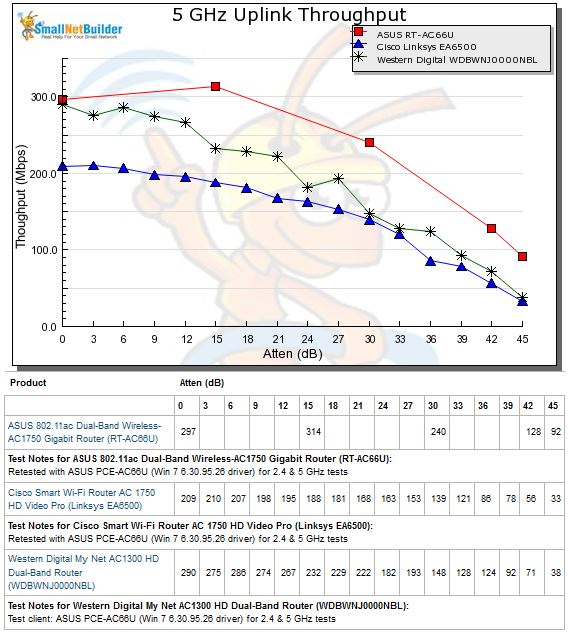
5 GHz Uplink Throughput vs. Attenuation comparison
Simultaneous uplink/downlink throughput in the strongest signal "Location A" (or with 0 dB attenuation) came in at an impressive 555 Mbps total throughput. This is the highest among the three routers tested; the results for the Linksys EA6500 was 491 Mbps and the ASUS RT-AC66U was 484 Mbps.
Time for a few IxChariot plots. Here’s a composite 5 GHz up and downlink plot with 0 dB attenutation. The delayed throughput upshift that seems to be a signature of Broadcom’s draft 11ac technology is once again clearly shown.

5 GHz IxChariot plot – 0 dB attenuation
There appears to be the same effect in the uplink trace in the equivalent 2.4 GHz composite plot shown below.

2.4 GHz IxChariot plot – 0 dB attenuation
Closing Thoughts
Given the similarity of designs, the first crop of draft 802.11ac routers have tended to be more alike than different. Among the three AC1750 routers tested or retested with our new wireless test process, the WD My Net AC1300 clearly performs more like the Linksys EA6500 than the ASUS RT-AC66U. Of the three, the ASUS has the edge in both wired routing and wireless performance, and sits in the #1 position in the Router Ranker for AC1750 class routers.
Between the Linksys EA6500 and the My Net AC1300, the Linksys does a bit better for wired routing throughput, but ranks behind the WD for both wireless throughput and wireless range.
Where the WD shines however, is in value. Both Linksys and ASUS are keeping their offerings up closer to $200, while you can pick up the My Net AC1300 for closer to $150.
With lower price, comparable performance and easy-to-use remote access to files stored on a hosted USB drive via WD 2go, the WD My Net AC1300 could be the router for you if you’re looking for a top-end draft 802.11ac router.
